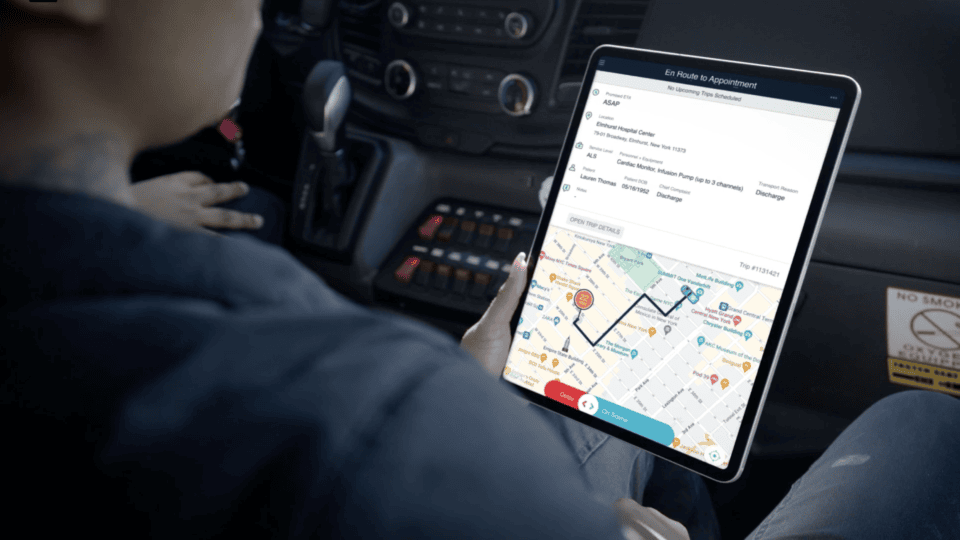The Unsung Hero of Healthcare: Transportation
Interfacility transportation plays a key role in reducing pressure on US health systems — and helping patients safely transition to the next stage of their care journey.
Find out how providers like DocGo are bridging care gaps across the country with new forms of medical transportation.
When you think of “medical transportation,” images of 9-1-1 operators and paramedics might spring to mind. There’s a lot more to it. It also includes services like moving hospital patients with complex medical needs to their next destination, whether that’s home or a specialty clinic. This service, known as interfacility transportation, plays a key role in helping reduce pressure on US health systems.
In times when hospital beds are scarce, interfacility transportation ensures patients can be discharged on time, freeing up space for new patients and preventing unnecessarily prolonged hospital stays. This service improves patient experiences and outcomes and conserves hospital resources for those in urgent need.
To understand how interfacility transportation keeps patients flowing through the healthcare system, it is important to first understand who it serves and how it functions.
The Journey for Patients with Complex Condition
When a hospital stay ends, many patients can simply be picked up by a loved one and taken home. Even for patients who are immobile, options like ambulettes or wheelchair-accessible vans have long been available. It is those with more complex medical needs – beyond what a regular vehicle and driver can accommodate – who depend on interfacility transportation.
Providers like DocGo address this challenge by staffing vehicles with specially trained paramedics and EMTs. The vehicles are also equipped with advanced medical equipment, including oxygen delivery systems, cardiac monitors, defibrillators, IV supplies, and airway management equipment.
The Challenges Facing Overstretched Health Systems
The impact of interfacility transportation on patient experience is evident. Its most significant benefit isn’t as obvious: the positive downstream impact on health systems, enhancing their capacity to provide care.
In a survey by the American College of Emergency Physicians, more than a quarter of ER doctors reported patients waiting over two weeks for a hospital bed. These long ER stays can result in a heightened risk of infection, psychological distress, family disruption, and physical decline. Long visits are particularly dangerous for elderly patients.
One of the main causes of the bed shortage is patient overstay. Patients with complex conditions often experience delays leaving the hospital, even when medically cleared to go home, due to the scarcity of safe transportation options. With patient turnover delayed and no new beds available, emergency room overcrowding is inevitable.
Interfacility transportation providers like DocGo target this gap, providing a safe transition between inpatient and outpatient care for all patients, regardless of their needs. Today, the company completes more than 600,000 safe patient transfers annually. This helps to prevent strain on hospital resources, lowers healthcare costs, and increases patient throughput.
How Technology Powers Efficient Patient Transfers
The success of interfacility transport hinges on more than high-quality patient care. To combat hospital overcrowding, it’s crucial that patient transports are timely and well-documented. Delays and poor communication create problems that neither patients nor doctors can afford.
Thanks to new technologies, medical transportation is now more efficient than ever.
Computer-aided dispatch software pairs patients with the right vehicles and medical teams, helping to ensure everyone receives the appropriate care. DocGo is a leader in this area, offering health systems access to Dara, DocGo’s proprietary transportation management solution which seamlessly coordinates schedules, plans routes, and tracks transfer requests. Dara offers real-time GPS tracking and live ETAs, keeping patient transfers fast and communications open. Recent updates to Dara have added support for multiple providers so that health systems can manage all their transport needs from one platform that integrates into the hospital Electronic Health Record (EHR) system.

Coordinating the safe transport of hundreds of high-risk patients daily is a formidable challenge – and one of the keys to freeing up capacity in overburdened health systems. With partners like DocGo facilitating a safe and smooth transition, patients and health systems can feel at ease, assured they’re supported by a team with the right people and technology to do the job.








